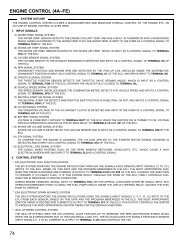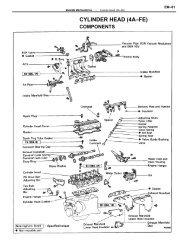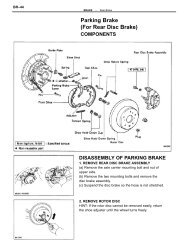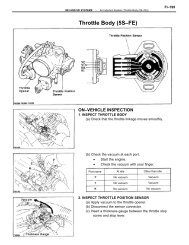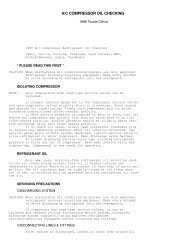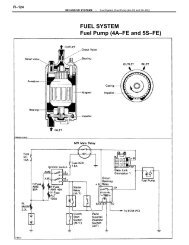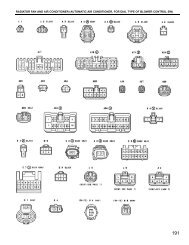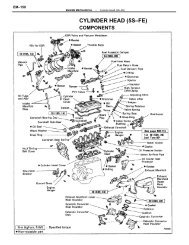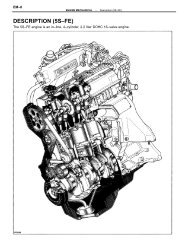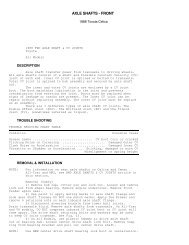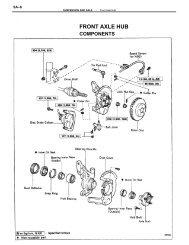Clutch - CelicaTech
Clutch - CelicaTech
Clutch - CelicaTech
You also want an ePaper? Increase the reach of your titles
YUMPU automatically turns print PDFs into web optimized ePapers that Google loves.
¡ ¡ ¡ ¡ ¡ ¡ ¡ ¡ ¡ ¡ ¡ ¡ ¡ ¡ ¡ ¡ ¡ ¡ ¡ ¡ ¡ ¡ ¡ ¡ ¡ ¡ ¡ ¡ ¡ ¡ ¡ ¡ ¡ ¡ ¡ ¡ ¡ ¡ ¡ ¡ ¡ ¡ ¡ ¡ ¡ ¡ ¡ ¡ ¡<br />
CLUTCH<br />
1994 Toyota Celica<br />
1994 <strong>Clutch</strong><br />
Celica<br />
DESCRIPTION<br />
The single, dry-type disc clutch uses a hydraulicallyoperated<br />
master cylinder with a clutch release cylinder mounted on<br />
clutch housing. <strong>Clutch</strong> release cylinder is nonadjustable. The clutch<br />
start system uses a clutch start switch which prevents the engine from<br />
starting unless clutch pedal is fully depressed.<br />
ADJUSTMENTS<br />
CLUTCH PEDAL HEIGHT<br />
1) Measure clutch pedal height from highest point of clutch<br />
pedal pad to the floor panel. See Fig. 1. Ensure clutch pedal height<br />
is within specification. See CLUTCH PEDAL HEIGHT SPECIFICATIONS table.<br />
2) If clutch pedal height adjustment is required, loosen lock<br />
nut and rotate bolt at clutch pedal height adjustment point until<br />
correct clutch pedal height is obtained. See Fig. 1. Check clutch<br />
pedal free play and push rod play. See CLUTCH PEDAL FREE PLAY & PUSH<br />
ROD PLAY under ADJUSTMENTS.<br />
CLUTCH PEDAL HEIGHT SPECIFICATIONS TABLE<br />
¡¡¡¡¡¡¡¡¡¡¡¡¡¡¡¡¡¡¡¡¡¡¡¡¡¡¡¡¡¡¡¡¡¡¡¡¡¡¡¡¡¡¡¡¡¡¡¡<br />
¡<br />
Application<br />
In. (mm)<br />
Celica ................. 5.86-6.25 (148.8-158.8)<br />
Fig. 1: <strong>Clutch</strong> Pedal Height, Push Rod Play & Adjustment Points<br />
Courtesy of Toyota Motor Sales, U.S.A., Inc.<br />
CLUTCH PEDAL FREE PLAY & PUSH ROD PLAY
1) To check clutch pedal free play, push clutch pedal<br />
downward until beginning of clutch resistance is felt. See Fig. 2.<br />
Note distance that clutch pedal moves. This is the clutch pedal free<br />
play.<br />
2) <strong>Clutch</strong> pedal free play should be .20-.59" (5.0-15.0 mm).<br />
If clutch pedal free play adjustment is required, loosen lock nut on<br />
push rod at master cylinder. See Fig. 1. Rotate push rod to obtain<br />
correct pedal free play. Tighten lock nut.<br />
3) To check push rod play, slightly push clutch pedal<br />
downward until slight resistance is felt. This is where the push rod<br />
starts to operate clutch master cylinder. Push rod play should be .<br />
039-.197" (1.00-5.00 mm) at top of clutch pedal. See Fig. 1. This<br />
ensures there is a slight amount of clearance at the push rod.<br />
4) If push rod play adjustment is required, loosen lock nut<br />
on push rod at master cylinder. See Fig. 1. Rotate push rod to obtain<br />
correct push rod play. Tighten lock nut. Recheck clutch pedal free<br />
play and clutch pedal height.<br />
Fig. 2: Measuring Typical <strong>Clutch</strong> Pedal Free Play<br />
Courtesy of Toyota Motor Sales, U.S.A., Inc.<br />
TESTING<br />
CLUTCH START SYSTEM<br />
Ensure engine does not start when clutch pedal is released.<br />
Ensure engine starts when clutch pedal is fully depressed. If system<br />
is not operating correctly, check clutch start switch. See CLUTCH<br />
START SWITCH under TESTING. If clutch start switch is okay, adjust<br />
clutch start switch for correct system operation.<br />
CLUTCH START SWITCH<br />
1) Disconnect electrical connector from clutch start switch,<br />
located near rear of clutch pedal. See Fig. 3. Using ohmmeter, ensure<br />
continuity exists between clutch start switch terminals when clutch<br />
pedal is fully depressed. This is ON position.
¡ ¡ ¡ ¡ ¡ ¡ ¡ ¡ ¡ ¡ ¡ ¡ ¡ ¡ ¡ ¡ ¡ ¡ ¡ ¡ ¡ ¡ ¡ ¡ ¡ ¡ ¡ ¡ ¡ ¡ ¡ ¡ ¡ ¡ ¡ ¡ ¡ ¡ ¡ ¡ ¡ ¡ ¡ ¡ ¡ ¡ ¡ ¡ ¡ ¡ ¡ ¡ ¡ ¡ ¡ ¡ ¡ ¡ ¡<br />
2) Ensure no continuity exists when clutch pedal is released.<br />
This is OFF position. The ON and OFF position is determined by<br />
distance that plunger extends from threaded end of clutch start<br />
switch. See Fig. 4.<br />
4) For proper distance to determine switch continuity, see<br />
CLUTCH START SWITCH PLUNGER CONTINUITY SPECIFICATIONS table.<br />
Replace or adjust clutch start switch as necessary. Reinstall<br />
electrical connector.<br />
CLUTCH START SWITCH PLUNGER CONTINUITY SPECIFICATIONS (1)<br />
¡¡¡¡¡¡¡¡¡¡¡¡¡¡¡¡¡¡¡¡¡¡¡¡¡¡¡¡¡¡¡¡¡¡¡¡¡¡¡¡¡¡¡¡¡¡¡¡¡¡¡¡¡¡¡¡¡¡<br />
¡<br />
Application<br />
In. (mm)<br />
Celica ............................. .295-.335 (7.50-8.50)<br />
(1) - Distance from threaded end of clutch start switch<br />
where continuity changes. See Fig. 4.<br />
Fig. 3: Identifying Typical <strong>Clutch</strong> Start Switch Location<br />
Courtesy of Toyota Motor Sales, U.S.A., Inc.
Fig. 4: Testing <strong>Clutch</strong> Start Switch<br />
Courtesy of Toyota Motor Sales, U.S.A., Inc.<br />
REMOVAL & INSTALLATION<br />
CLUTCH ASSEMBLY<br />
WARNING: To prevent air bag deployment, disconnect negative battery<br />
cable and wait at least 90 seconds before working on vehicle.<br />
Removal<br />
1) Disconnect negative battery cable. On 2.2L (5S-FE) models,<br />
remove battery and cruise control actuator. On all models, remove air<br />
cleaner case with air intake hose. Remove clutch release cylinder with<br />
hose attached and secure aside.<br />
2) Remove starter. Disconnect necessary ground straps,<br />
electrical connections and control cables from transaxle. Remove upper<br />
transaxle mounting bolts from cylinder block.<br />
3) Raise and support vehicle. Remove front wheels. Remove<br />
lower engine covers. Drain transaxle fluid. Remove axle shafts from<br />
transaxle. See the AXLE SHAFTS - 1.8L, or the<br />
AXLE SHAFTS - 2.2L article in DRIVE AXLES.<br />
4) Remove front exhaust pipe, located below oil pan. Remove<br />
front exhaust pipe support bracket. On 2.2L (5S-FE), remove stiffener<br />
plate, located between cylinder block and transaxle, at rear of oil<br />
pan.<br />
5) On all models, support engine with hoist. Using<br />
transmission jack, slightly raise transaxle to remove weight from<br />
engine mounts.<br />
6) Remove front (exhaust manifold side) engine mount-tocrossmember<br />
bolts/nuts. Remove rear (intake manifold side) engine
mount-to-crossmember bolts/nuts.<br />
7) Remove front (exhaust manifold side) engine mount and rear<br />
(intake manifold side) engine mount brackets from cylinder block.<br />
Remove bolts and crossmember, located below engine and transaxle.<br />
Remove transaxle mount bolts.<br />
8) Remove remaining transaxle mounting bolts. Slightly lower<br />
engine and remove transaxle. Place a reference mark on clutch cover<br />
and flywheel for reassembly reference.<br />
9) Alternately loosen clutch cover bolts until spring tension<br />
is released. Remove clutch cover and clutch disc. Remove clutch<br />
release fork, clutch release bearing and pivot stud from transaxle (if<br />
necessary). See Fig. 5.<br />
Inspection<br />
1) Check wear on facings of clutch disc by measuring depth of<br />
each rivet head. Minimum depth at any rivet is .012" (.30 mm). Check<br />
clutch disc runout. Maximum runout at facing on clutch disc is .031"<br />
(.80 mm). Replace clutch disc if not within specification.<br />
2) Using dial indicator, check flywheel runout. Replace<br />
flywheel if flywheel runout is greater than .004" (.10 mm).<br />
3) Using caliper, measure depth and wear on diaphragm spring<br />
on clutch cover. See Fig. 6. Maximum depth is .024" (.60 mm) and<br />
maximum width is .197" (5.00 mm). Replace clutch cover if necessary.<br />
4) Ensure clutch release bearing rotates smoothly. Replace<br />
clutch release bearing if necessary.<br />
Installation<br />
1) If installing flywheel, apply thread sealant on threads of<br />
flywheel bolts before installing. Install and alternately tighten<br />
flywheel bolts in a crisscross pattern to specification. See TORQUE<br />
SPECIFICATIONS.<br />
2) Install clutch disc in clutch cover. Align reference marks<br />
on clutch cover and flywheel. Install clutch disc and clutch cover on<br />
flywheel.<br />
3) Using clutch aligner, center clutch disc on flywheel.<br />
Install and alternately tighten clutch cover bolts in a crisscross<br />
pattern to specification. See TORQUE SPECIFICATIONS table.<br />
4) Apply molybdenum disulfide grease to clutch release forkto-pivot<br />
stud contact surfaces, hub on clutch release bearing and<br />
clutch disc splines. Install clutch release fork and clutch release<br />
bearing on transaxle (if removed).<br />
5) To install remaining components, reverse removal<br />
procedure. Tighten bolt/nuts to specification. See TORQUE<br />
SPECIFICATIONS. Fill transaxle with 75W-90 gear oil with API GL-4 or<br />
GL-5 rating.<br />
WARNING: To prevent air bag deployment, disconnect negative battery<br />
cable and wait at least 90 seconds before working on vehicle.<br />
Fig. 5: Exploded View Of Typical <strong>Clutch</strong> Assembly<br />
Courtesy of Toyota Motor Sales, U.S.A., Inc.
Fig. 6: Checking Diaphragm Spring Depth & Width<br />
Courtesy of Toyota Motor Sales, U.S.A., Inc.<br />
CLUTCH MASTER CYLINDER<br />
Removal & Installation<br />
1) Use syringe to remove brake fluid from clutch master<br />
cylinder.<br />
2) Remove clip and clevis pin from push rod assembly at<br />
clutch pedal. Disconnect hydraulic line at clutch master cylinder.<br />
Remove nuts and clutch master cylinder.<br />
3) To install, reverse removal procedure. Bleed hydraulic<br />
system. Adjust clutch pedal height, clutch free play and push rod<br />
play. See CLUTCH PEDAL HEIGHT and CLUTCH PEDAL FREE PLAY & PUSH ROD<br />
PLAY under ADJUSTMENTS.<br />
CLUTCH RELEASE CYLINDER<br />
Removal & Installation<br />
Disconnect hydraulic line at clutch release cylinder. Remove<br />
bolts and clutch release cylinder. To install, reverse removal<br />
procedure. Bleed hydraulic system.<br />
OVERHAUL<br />
NOTE:<br />
For exploded view of typical clutch master cylinder, see<br />
Fig. 7. For exploded view of typical clutch release<br />
cylinder, see Fig. 8.
Fig. 7: Exploded View Of Typical <strong>Clutch</strong> Master Cylinder<br />
Courtesy of Toyota Motor Sales, U.S.A., Inc.<br />
Fig. 8: Exploded View Of Typical <strong>Clutch</strong> Release Cylinder<br />
Courtesy of Toyota Motor Sales, U.S.A., Inc.<br />
TORQUE SPECIFICATIONS<br />
TORQUE SPECIFICATIONS TABLE<br />
¡¡¡¡¡¡¡¡¡¡¡¡¡¡¡¡¡¡¡¡¡¡¡¡¡¡¡¡¡¡¡¡¡¡¡¡¡¡¡¡¡¡¡¡¡¡¡¡¡¡¡¡¡¡¡¡¡¡<br />
¡<br />
Application<br />
Ft. Lbs. (N.m)<br />
<strong>Clutch</strong> Cover Bolt ................................ 14 (19)
Crossmember Bolt<br />
1.8L (7A-FE) ................................... 26 (35)<br />
2.2L (5S-FE) ................................... 38 (52)<br />
Exhaust Pipe Support Bracket Bolt/Nut ............ 14 (19)<br />
Flywheel Bolt<br />
1.8L (7A-FE) ................................... 58 (79)<br />
2.2L (5S-FE) ................................... 65 (88)<br />
Front (Exhaust Manifold Side) Engine<br />
Mount Bracket-To-Cylinder Block Bolt ............ 57 (77)<br />
Front (Exhaust Manifold Side) Engine<br />
Mount-To-Crossmember Bolt/Nut<br />
1.8L (7A-FE) ................................... 59 (80)<br />
2.2L (5S-FE) ................................... 47 (64)<br />
Front (Exhaust Manifold Side) Engine<br />
Mount Through-Bolt ............................... 64 (87)<br />
Pivot Stud-To-Transaxle<br />
1.8L (7A-FE) ................................... 27 (37)<br />
2.2L (5S-FE) ................................... 29 (39)<br />
Rear (Intake Manifold Side) Engine<br />
Mount Bracket-To-Cylinder Block Bolt ............ 57 (77)<br />
Rear (Intake Manifold Side) Engine<br />
Mount Through-Bolt .............................. 64 (87)<br />
Rear (Intake Manifold Side) Engine<br />
Mount-To-Crossmember Bolt/Nut<br />
1.8L (7A-FE) .................................. 59 (80)<br />
2.2L (5S-FE) .................................. 47 (64)<br />
Starter Bolt ..................................... 29 (39)<br />
Stiffener Plate Bolt - 2.2L (5S-FE)<br />
Cylinder Block Side ............................ 32 (43)<br />
Transaxle Side ................................. 15 (20)<br />
Transaxle Mounting Bolt<br />
10-mm Bolt ..................................... 34 (46)<br />
12-mm Bolt ..................................... 47 (64)<br />
Transaxle-To-Mount Bolt .......................... 47 (64)<br />
Wheel Lug Nut ................................... 76 (103)<br />
¡ ¡ ¡ ¡ ¡ ¡ ¡ ¡ ¡ ¡ ¡ ¡ ¡ ¡ ¡ ¡ ¡ ¡ ¡ ¡ ¡ ¡ ¡ ¡ ¡ ¡ ¡ ¡ ¡ ¡ ¡ ¡ ¡ ¡ ¡ ¡ ¡ ¡ ¡ ¡ ¡ ¡ ¡ ¡ ¡ ¡ ¡ ¡ ¡ ¡ ¡ ¡ ¡ ¡ ¡ ¡ ¡ ¡ ¡



